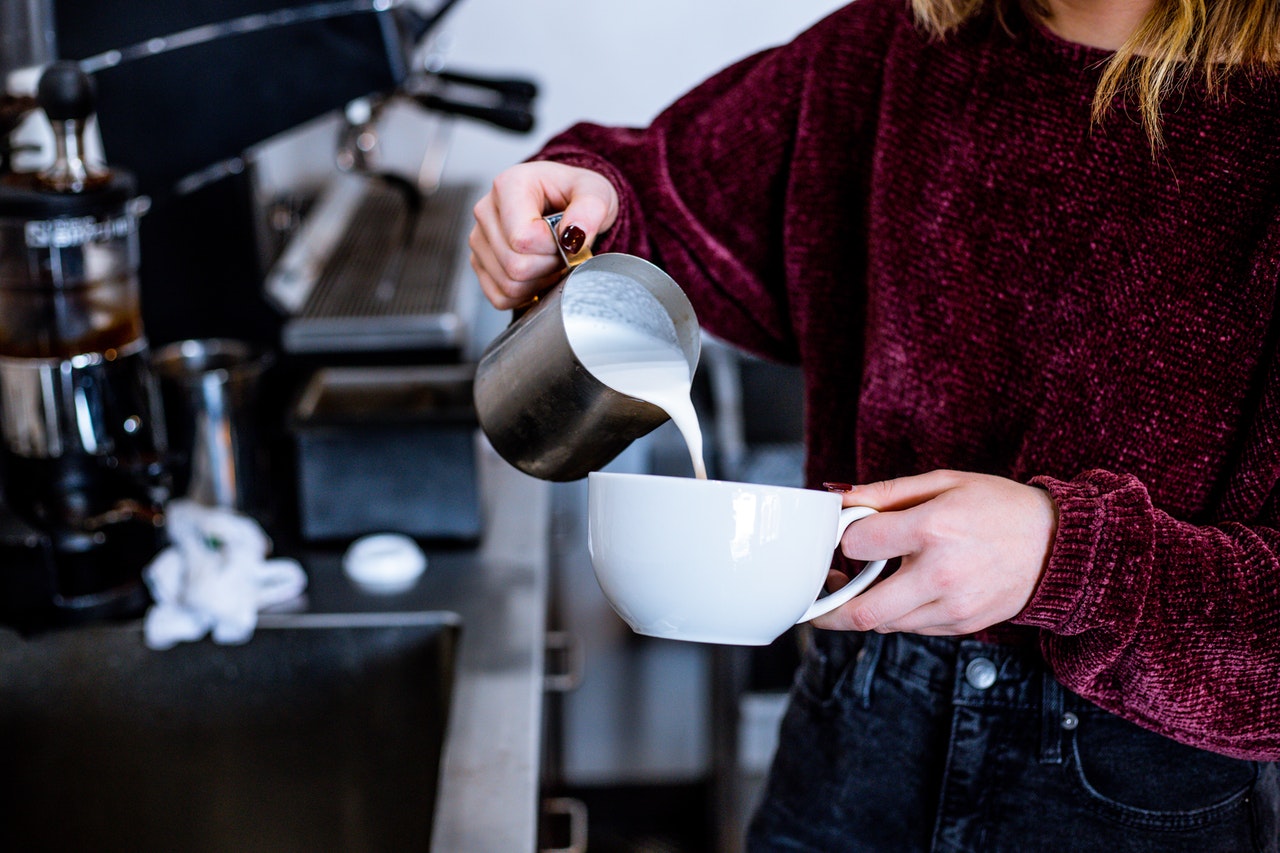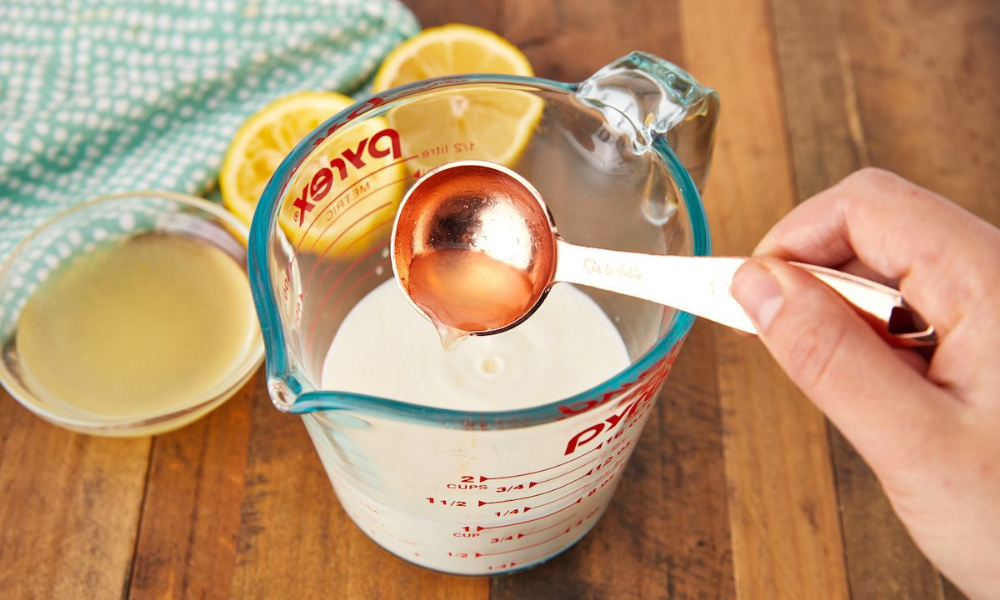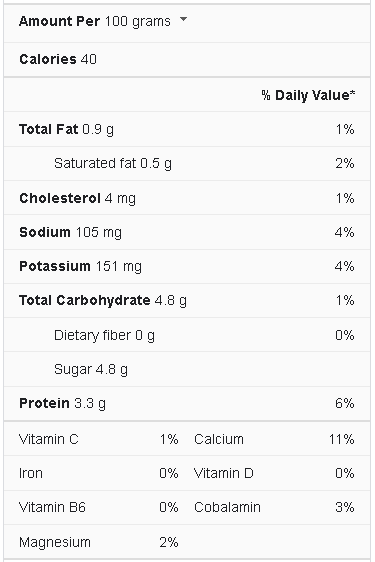Buttermilk is a versatile kitchen staple that adds tang to everything from salad dressing to freshly baked bread to fried chicken. We’ve all been in the middle of a recipe when we realized we were missing buttermilk! Fortunately, creating your own buttermilk is straightforward and involves only two ingredients. Traditional buttermilk is hard to get by. Buttermilk manufactured commercially is frequently available at larger stores. You may create your own by mixing whole milk with a squeeze of lemon juice and letting it sit for a few minutes to thicken.
Buttermilk was once thought to be the fermenting liquid leftover after churning cream into butter. Typically, store-bought buttermilk is produced from milk with lactic bacteria added to make lactic acid. Buttermilk is not buttery and has low-fat content and a thicker texture, contrary to its name. Store-bought alternatives are usually comparable to whole milk; however, reduced-fat variants are available.
Buttermilk Nutrition Facts
What Is Buttermilk?
Buttermilk is divided into two types. Traditional buttermilk is a thin, cloudy, slightly tart, but a buttery-tasting liquid leftover from the churning of cream to make butter. It is now more commonly sold as a thick liquid made by adding an acidifying bacteria to milk and flavouring and thickening agents.
This commercial product can be compared to a milder, thinner yogurt with a buttery flavour. Buttermilk is typically consumed as a beverage, but it is increasingly used in baking. It reacts with baking soda to produce carbon dioxide, which aids in the rising of doughs like soda bread, rolls, scones, and waffles. It can also be used as a marinade because the acidity helps tenderize and flavour the meat. Some chicken dishes call for buttermilk in this form.
How to Make Buttermilk?
It’s a game-changer to learn how to produce buttermilk because it’s simple. We’ve all been in the situation where you’re in the middle of a recipe and discover you’re missing an ingredient. It’s a lot of pressure. That will never happen again when it comes to buttermilk.
There are occasions when you don’t require much buttermilk and don’t want to purchase an entire carton. This is also ideal for that purpose. You can manufacture exactly how much you need. It has a tangy flavour that works well in a variety of cuisines. Making your own is such a lifesaver; if only it were that simple with every component!
Ingredients
- Milk: Dairy milk, do not use non-dairy milk.
- Lemon Juice or White Vinegar: Fresh lemon juice and white vinegar are winners but bottled, and cider vinegar will work.
Instructions
-
Stir together milk and lemon juice or vinegar.
-
Let it sit 5-10 minutes after mixing to thicken and create that tang flavour.
How to Cook With Buttermilk?
When using buttermilk as leavening with baking soda, it’s best to let it come to room temperature before use. This reaction happens immediately, so it is faster than baking powder, which works only when heat is present. If the buttermilk is still refrigerated, the dough might be set before the reaction has time to work fully, and the result will be heavier. If you can’t get buttermilk for baking or don’t have enough, plain yogurt works just as well but will give a slightly different flavour.
In a buttermilk fried chicken dish, use buttermilk as a marinade for crunchy, tender fried chicken. To make fluffy pancakes with maple apples, add buttermilk to the batter. Buttermilk is used in a classic pound cake to achieve the perfect texture; try it in a lemon and buttermilk pound cake. Try a buttermilk-dressed green salad and a great dressing for crisp salads and slaws.
What Can I Substitute for Buttermilk?
Although buttermilk was once a byproduct of the butter-making process, modern buttermilk is manufactured by fermenting milk with lactic acid bacteria. It’s used to make biscuits, pancakes, waffles, muffins, and cakes since it has a tangy flavour and a thicker consistency than milk.
Buttermilk lends a soft, moist feel to baked products. Its acidity activates baking soda and functions as a raising agent in recipes. Many people, however, do not keep it on hand, while others may not use it due to dietary concerns. Surprisingly, you can make buttermilk alternatives with components you probably already have in your cupboard or fridge, whether dairy-based or nondairy.
Here is some substitute for buttermilk:
Milk and vinegar
When you add vinegar to milk, it takes on the acidity of buttermilk. You can use apple cider vinegar or distilled white vinegar; however, distilled white vinegar has a more neutral flavour. You can use any milk, but if your recipe calls for a specific type of buttermilk, such as low fat, it’s preferable to substitute with a similar type of milk.
Add one tablespoon (15 mL) vinegar to a liquid measuring cup to make a 1 cup (240 mL) buttermilk alternative. Then, add milk and whisk to the 1-cup line (240 mL). You’ll need a scant — or not quite full — cup if you measure the milk separately (around 220 mL). Although many sites recommend waiting 5–10 minutes before using the combination in a dish, experts say this isn’t necessary.
Milk and Lemon Juice
When making buttermilk, lemon juice can be substituted for vinegar. In a liquid measuring cup, add one tablespoon (15 mL) lemon juice to make 1 cup (240 mL) buttermilk alternative. Then, add milk and whisk to the 1-cup line (240 mL). You can use either freshly squeezed lemon juice or lemon juice from a bottle. Preservatives like sodium benzoate and sodium sulphite are commonly found in bottled types. Sulphites may trigger some people’s asthma symptoms.
Milk and Cream of Tartar
Cream of tartar, also known as potassium bitartrate, is another acidic material used with milk to form a buttermilk alternative. This fine white powder is a byproduct of the winemaking process and has no flavour.1 3/4 teaspoons (5 grams) cream of tartar per 1 cup (240 mL) milk makes a buttermilk alternative. When cream of tartar is mixed directly into milk, it tends to clump.
As a result, it’s preferable to combine the cream of tartar with the remaining dry ingredients in your recipe before adding the milk. To avoid clumping, whisk two tablespoons (30 mL) cream of tartar with two tablespoons (30 mL) of milk, then add this mixture to the rest of the milk.
Lactose-free Milk and Acid
Because buttermilk has less lactose than ordinary milk, lactose intolerance sufferers may be able to handle it. If you have severe lactose intolerance, though, you can prepare a buttermilk alternative with lactose-free milk, albeit it will be slightly sugary (4). Pour one tablespoon (15 mL) of lemon juice or vinegar into a liquid measuring cup. Then, to the 1-cup line (240 mL), add lactose-free milk and mix.
How to Extend Buttermilk’s Shelf Life?
If you want to keep your buttermilk for as long as possible, make sure you handle it with care. Please keep your hands clean, avoid coming into close touch with the bottle’s lip, and don’t drink directly from it. For most dairy products, Buttermilk should be kept chilled below 40°F (4.4°C) to prevent bacterial growth. Avoid storing it in your refrigerator’s door, subject to the largest temperature variations.
Buttermilk should not be left out at room temperature. Return it to the fridge as soon as possible after use to avoid reaching the danger zone, a temperature range of 40–140°F (4.4–60°C), where bacteria development accelerates. Finally, if you’re concerned about food waste, buy the smallest size possible and use it before expiration.
Conclusion
Buttermilk is a tangy, tasty beverage that tastes wonderful and works well in various baking and cooking recipes. Most store-bought buttermilk is cultured buttermilk, manufactured differently from traditional buttermilk. Both, however, have a short shelf life and should be kept refrigerated at temperatures below 40°F (4.4°C).
Buttermilk that has been opened can be kept in the fridge for up to 14 days, while unopened buttermilk can be kept slightly longer than its expiration date. It can be frozen for up to 3 months, either opened or unopened, in an airtight container. If the scent or appearance of your buttermilk changes, it’s important to discard it to avoid becoming ill.


